Demand Forecasting DBA Algorithm for Reducing Packet Delay with Efficient Bandwidth Allocation in XG-PON
Abstract
1. Introduction
2. Traditional DBA Process
3. DF-DBA Process and Algorithm
4. Simulation Design Environment
4.1. Platform
- As the fundamental intention about this module was once according to analyze XG-PON Transmission Convergence (XGTC) strata then top layer issues, the physical seam is within an easy path via carrying an excellent limit budget, because of the optical allocation network.
- Module implementation does not feature Physical Layer Operations, Administration or Maintenance (PLOAM) and ONU Management yet Control Interface (OMCI) channels are now not implemented.
- XG-PON aqueduct is modelled, so an easy point-to-multipoint (P2MP) race among Down Stream (and multipoint-to-point MP2P within Up Stream) together with propagation delays and rank charges have been configured such care of standards. Conversely, the packets are expected according to arrive, barring someone XG-PON losses, at their same recipients.
- DBA at the OLT is accountable in imitation of allocating the US bandwidth according to TCONT, or US scheduler at ONU is responsible according to assign the transmission possibility regarding some TCONT according to its US XGEM Ports.
- OLT and ONU keep sufficiently significant and separated queue, because of every XGEM Port-ID.
- All ONUs are double to remain at an equal distance out of OLT.
4.2. Simulation Environment
5. Results and Discussions
5.1. Throughput
5.2. Packet Delivery Ratio
5.3. End-to-End Delay
6. Conclusions
Author Contributions
Funding
Conflicts of Interest
References
- Keshav, S. Paradoxes of Internet Architecture. IEEE Internet Comput. 2018, 22, 96–102. [Google Scholar] [CrossRef]
- Sapolsky, H.M.; Crane, R.J.; Neuman, W.R.; Noam, E.M. The Telecommunications Revolution: Past, Present, and Future, 1st ed.; Routledge: Oxfordshire, UK, 2018; ISBN 978-0815361923. [Google Scholar]
- Chatterjee, B.; Sarma, N.; Sahu, P.; Oki, E. Limitations of Conventional WDM Optical Networks and Elastic Optical Networks for Possible Solutions. In Routing and Wavelength Assignment for WDM-Based Optical Networks; Springer: Cham, Switzerland, 2017; Volume 410. [Google Scholar]
- Pachnicke, S.; Eiselt, M.H.; Grobe, K.; Elbers, J. The frontiers of optical access networks. In Proceedings of the 2015 International Conference on Optical Network Design and Modeling (ONDM), Pisa, Italy, 11–14 May 2015; pp. 12–15. [Google Scholar]
- ITU-T 10-Gigabit-capable passive optical networks (XG-PON): General requirements. ITU-T Recomm. G.987.1 2010, E 40850, 1–58. [CrossRef]
- ITU-T G.9807.1:10-Gigabit-capable symmetrical passive optical network (XGS-PON). ITU-T G-SERIES Recomm. 2016, E 41042, 1–286.
- Arokkiam, J.A.; Alvarez, P.; Wu, X.; Brown, K.N.; Sreenan, C.J.; Ruffini, M.; Marchetti, N.; Doyle, L.; Payne, D. Design, implementation, and evaluation of an XG-PON module for the ns-3 network simulator. Simulation 2017, 93, 409–426. [Google Scholar] [CrossRef]
- Arokkiam, J.A.; Wu, X.; Brown, K.N.; Sreenan, C.J. Experimental evaluation of TCP performance over 10Gb/s passive optical networks (XG-PON). In Proceedings of the 2014 IEEE Global Communications Conference, Austin, TX, USA, 8–12 December 2014; pp. 2223–2228. [Google Scholar]
- Available online: http://www.sopto.com/st/ftth-knowledge/what-is-optical-distribution-network (accessed on 20 May 2018).
- Arokkiam, J.; Brown, K.; Sreenan, C. Refining the GIANT dynamic bandwidth allocation mechanism for XG-PON. In Proceedings of the 2015 IEEE International Conference on Communications (ICC), London, UK, 8–12 June 2015. [Google Scholar]
- ITU-T G.984.3. Gigabit-Capable Passive Optical Networks (G-PON): Transmission Convergence Layer Specification; Internation Telecommunication Union: Geneva, Switzerland, 2014. [Google Scholar]
- Dhaini, A.R.; Ho, P.; Shen, G.; Shihada, B. Energy Efficiency in TDMA-Based Next-Generation Passive Optical Access Networks. IEEE/ACM Trans. Netw. 2014, 22, 850–863. [Google Scholar] [CrossRef]
- Garfias, P.; De Andrade, M.; Tornatore, M.; Buttaboni, A.; Sallent, S.; Gutierrez, L. Energy-Saving Mechanism in WDM/TDM-PON Based on Upstream Network Traffic. Photonics 2014, 1, 235–250. [Google Scholar] [CrossRef]
- Segarra, J.; Sales, V.; Prat, J. GPON scheduling disciplines under multi-service bursty traffic and long-reach approach. In Proceedings of the 2010 12th International Conference on Transparent Optical Networks, Munich, Germany, 27 June–1 July 2010. [Google Scholar]
- Kwang, K.H.; Harle, D.; Andonovic, I. Dynamic bandwidth allocation algorithm for differentiated sservices over WDM EPONs. In Proceedings of the 2004 Ninth International Conference onCommunications Systems, Singapore, 7 September 2004; pp. 116–120. [Google Scholar]
- Butt, R.; Ashraf, M.; Faheem, M.; Idrus, S. A Survey of Dynamic Bandwidth Assignment Schemes for TDM-Based Passive Optical Network. J. Opt. Commun. 2018. [Google Scholar] [CrossRef]
- ITU-T G.987.3:10-Gigabit-capable passive optical networks (XG-PON): Transmission convergence (TC) layer specification. ITU-T G-Ser. Recomm. 2014, 2.0, 1–146.
- Wu, X.; Brown, K.N.; Sreenan, C.J.; Arokkiam, J.; Alvarez, P.; Ruffini, M.; Nicola, M.; Doyle, L. An XG-PON Module for the NS-3 Network Simulator: The Manual; University College Cork: Cork, Ireland, 2013. [Google Scholar]
- Byun, H.-J.; Nho, J.-M.; Lim, J.-T. Dynamic bandwidth allocation algorithm in Ethernet passive optical networks. Electron. Lett. 2003, 39, 1001–1002. [Google Scholar] [CrossRef]
- Luo, Y.; Ansari, N. Limited sharing with traffic prediction for dynamic bandwidth allocation and QoS provisioning over Ethernet passive optical networks. J. Opt. Netw. 2005, 4, 561–572. [Google Scholar] [CrossRef]
- Turna, Ö.C.; Aydin, M.A.; Zaim, A.H.; Atmaca, T. Half cycling dynamic bandwidth allocation with prediction on EPON. In Proceedings of the 2012 IEEE Symposium on Computers and Communications (ISCC), Cappadocia, Turkey, 1–4 July 2012; pp. 898–902. [Google Scholar]
- Kramer, G.; Mukherjee, B.; Pesavento, G. IPACT a dynamic protocol for an Ethernet PON (EPON). IEEE Commun. Mag. 2002, 40, 74–80. [Google Scholar] [CrossRef]
- Zhu, Y.; Ma, M. IPACT With Grant Estimation (IPACT-GE) Scheme for Ethernet Passive Optical Networks. J. Lightw. Technol. 2008, 26, 2055–2063. [Google Scholar] [CrossRef]
- Hwang, I.-S.; Lee, J.Y.; Yeh, T.-J. Polling cycle time analysis for waited-based DBA in GPONs. In Proceedings of the International MultiConference of Engineers and Computer Scientists, Hong Kong, China, 13–15 March 2013; Volume 2203. [Google Scholar]
- Qi-yu, Z.; Bin, L.; Run-ze, W. A Dynamic Bandwidth Allocation Scheme for GPON Based on Traffic Prediction. In Proceedings of the 2012 9th International Conference on Fuzzy Systems and Knowledge Discovery, Chongqing, China, 29–31 May 2012; pp. 2043–2046. [Google Scholar]
- Kyriakopoulos, C.A.; Papadimitriou, G.I. Predicting and allocating bandwidth in the optical access architecture XG-PON. Opt. Switch. Netw. 2017, 25, 91–99. [Google Scholar] [CrossRef]
- Babai, M.Z.; Dallery, Y.; Boubaker, S.; Kalai, R. A new method to forecast intermittent demand in the presence of inventory obsolescence. Int. J. Prod. Econ. 2018. [Google Scholar] [CrossRef]
- Prak, D.; Teunter, R. A general method for addressing forecasting uncertainty in inventory models. Int. J. Forecast. 2018. [Google Scholar] [CrossRef]
- Lopez Farias, R.; Puig, V.; Rodriguez Rangel, H.; Flores, J.J. Multi-Model Prediction for Demand Forecast in Water Distribution Networks. Energies 2018, 11, 660. [Google Scholar] [CrossRef]
- Rafiei, M.; Niknam, T.; Aghaei, J.; Shafie-Khah, M.; Catalão, J.P.S. Probabilistic Load Forecasting Using an Improved Wavelet Neural Network Trained by Generalized Extreme Learning Machine. IEEE Trans. Smart Grid 2018, 9, 6961–6971. [Google Scholar] [CrossRef]
- Zhang, Q.; Song, T.; Cao, J.; Chen, S.; Du, H.; Wu, Z. The Application of Genetic Grey Neural Network in Equipment Demand Forecasting. In Proceedings of the 2018 2Nd International Conference on Management Engineering, Software Engineering and Service Sciences, Wuhan, China, 13–15 January 2018; ACM: New York, NY, USA, 2018; pp. 84–87. [Google Scholar]
- Agrawal, A.; Udmale, S.S.; Sambhe, V.K. Extended Four-Step Travel Demand Forecasting Model for Urban Planning. In Information and Communication Technology for Sustainable Development; Mishra, D.K., Nayak, M.K., Joshi, A., Eds.; Springer: Singapore, 2018; pp. 191–198. [Google Scholar]
- Mazar, S.T.; Manicka, Y.D. Enabling Data Communication between an Implantable Medical Device and a Patient Management System. U.S. Patent No. 9,578,449, 21 February 2017. [Google Scholar]
- Henderson, T.R.; Lacage, M.; Riley, G.F.; Dowell, C.; Kopena, J. Network Simulations with the ns-3 Simulator. SIGCOMM Demonstr. 2008, 14, 527. [Google Scholar]
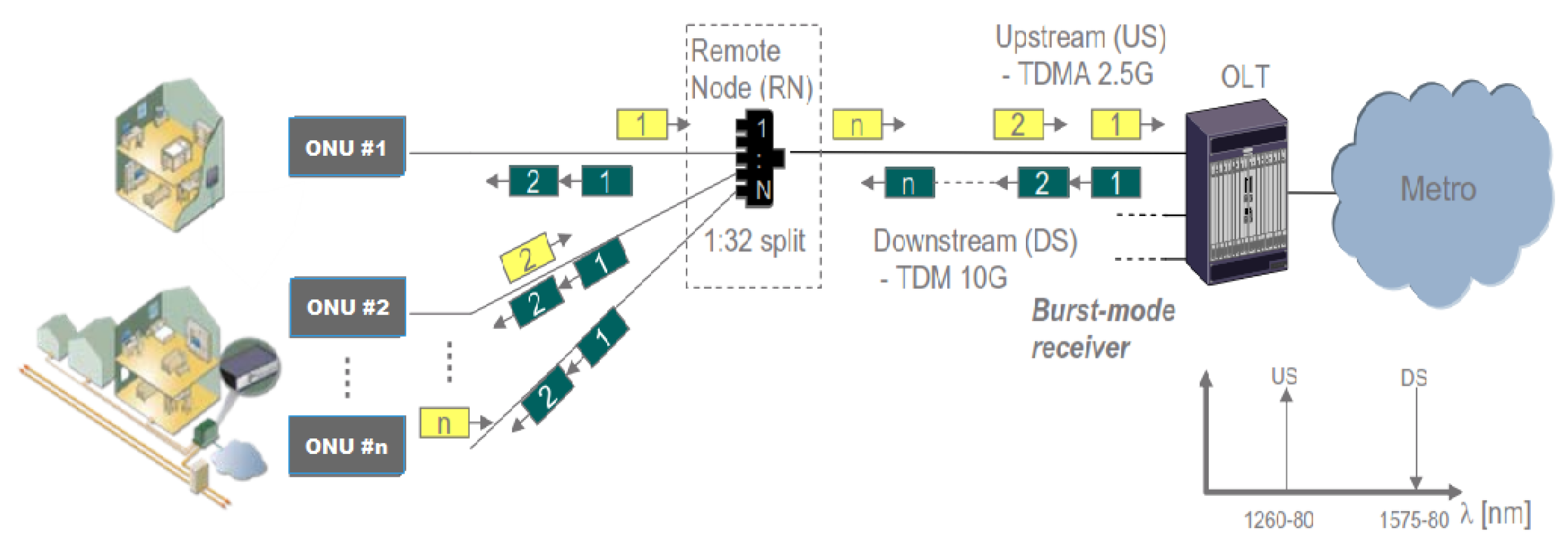

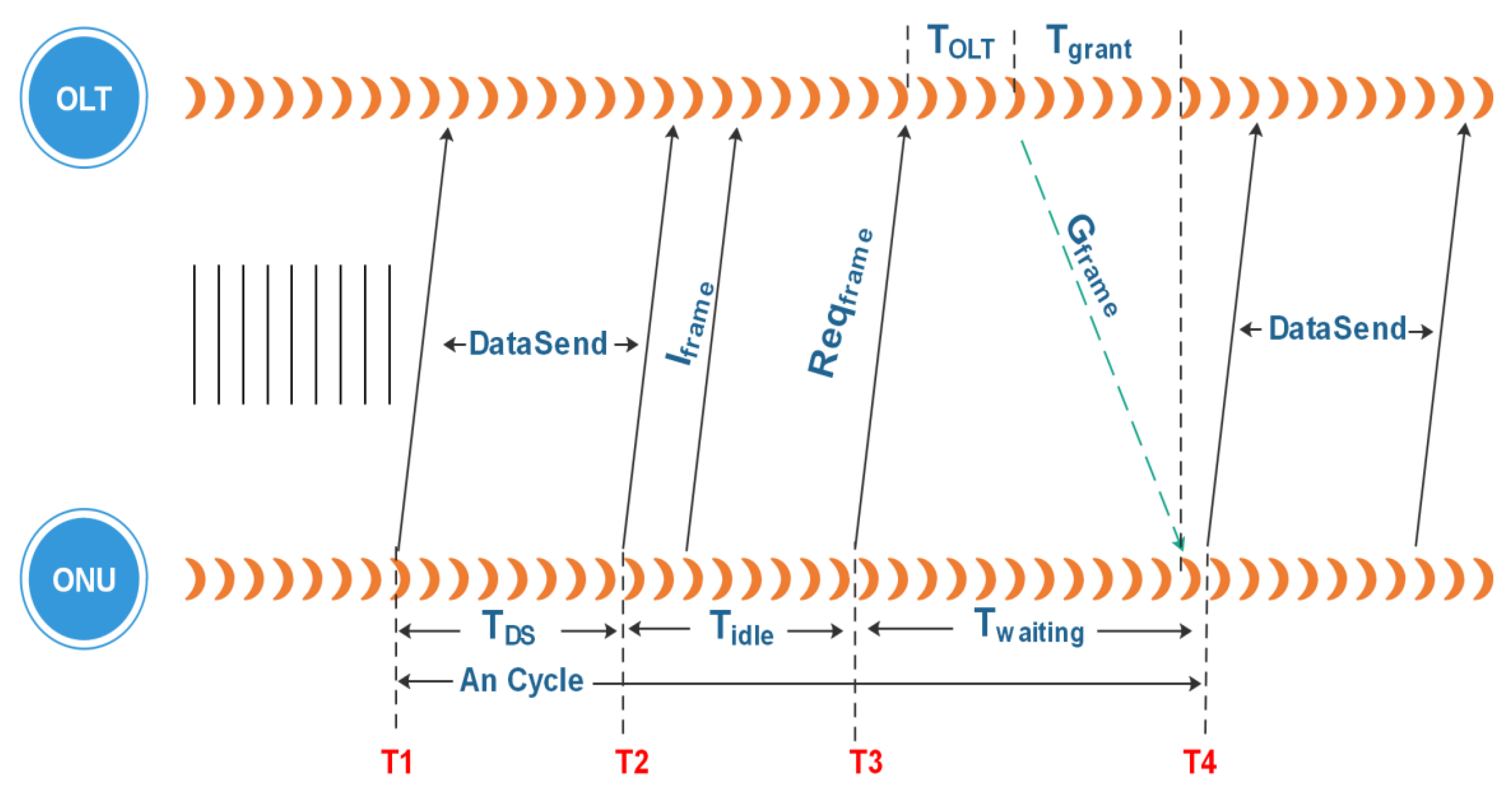
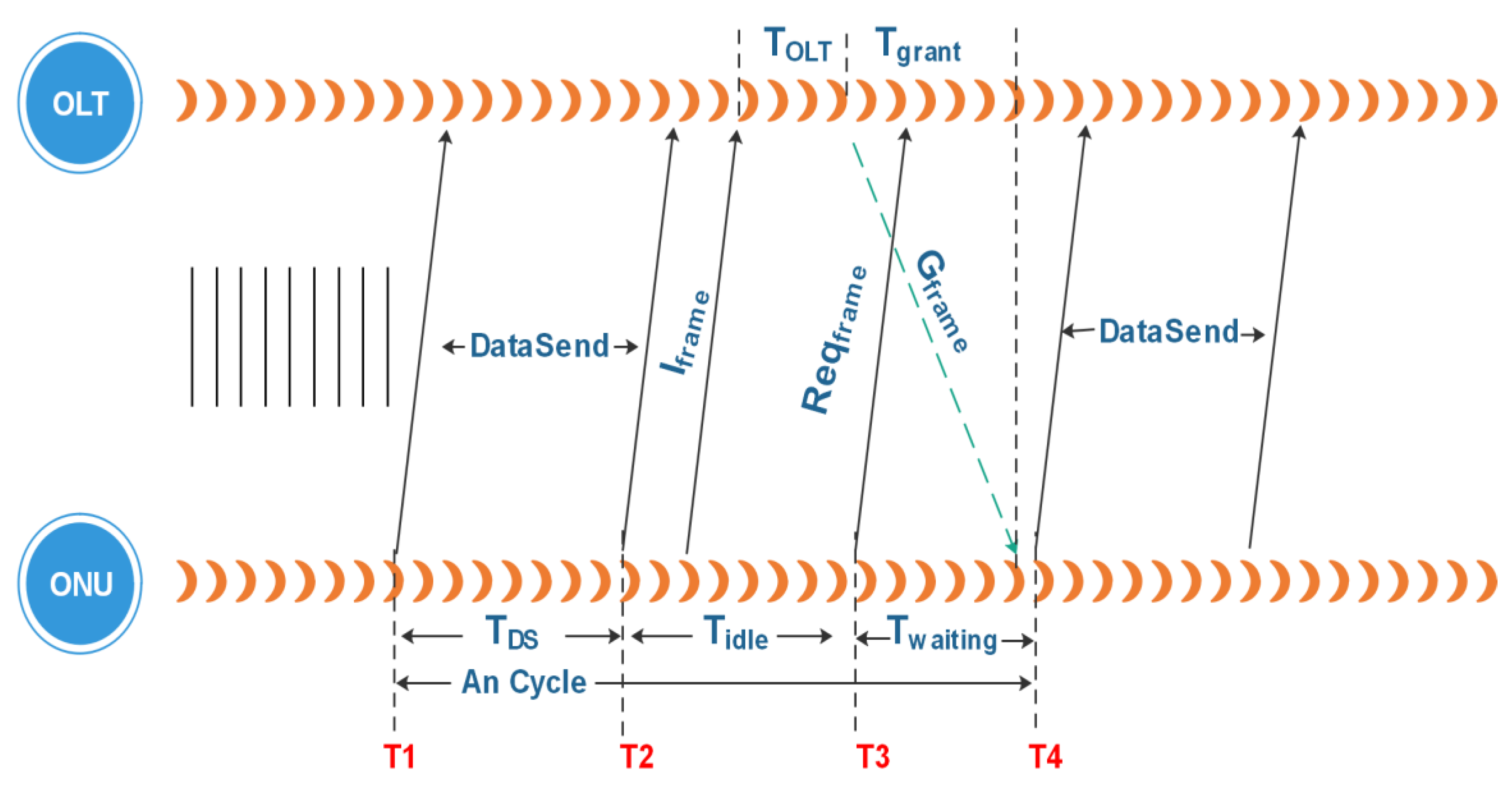
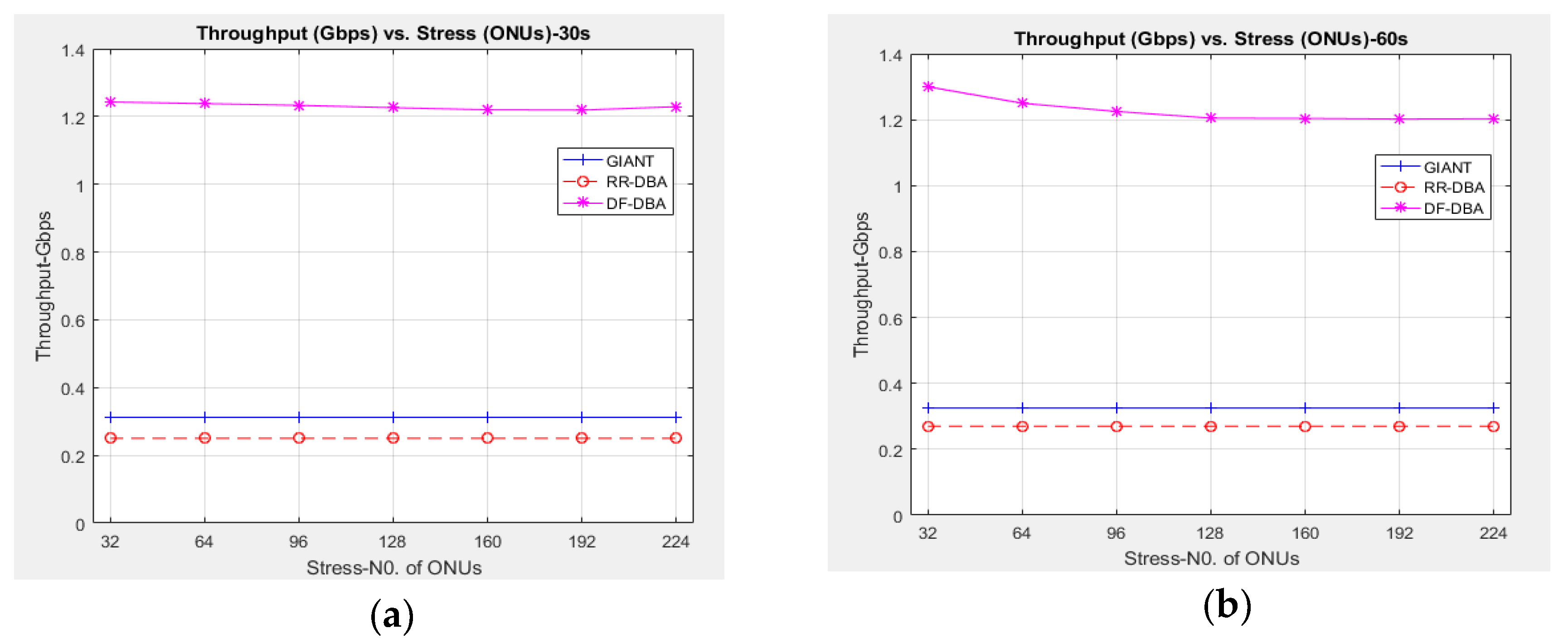
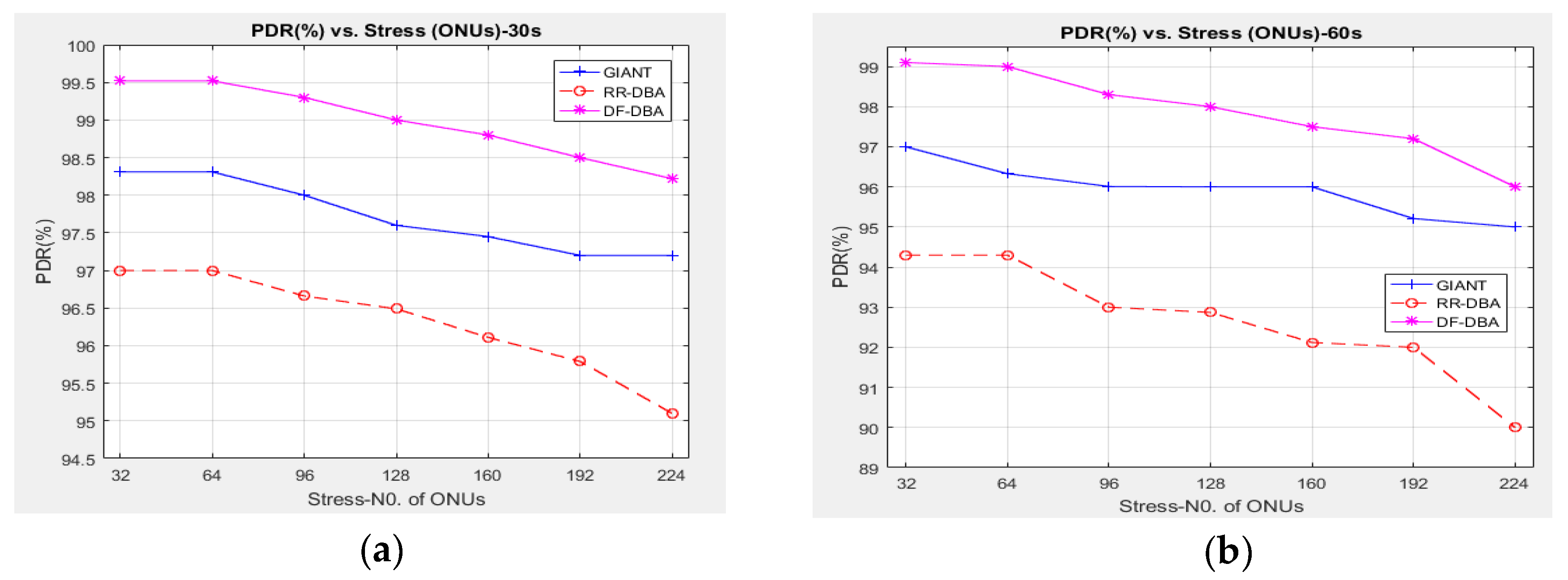
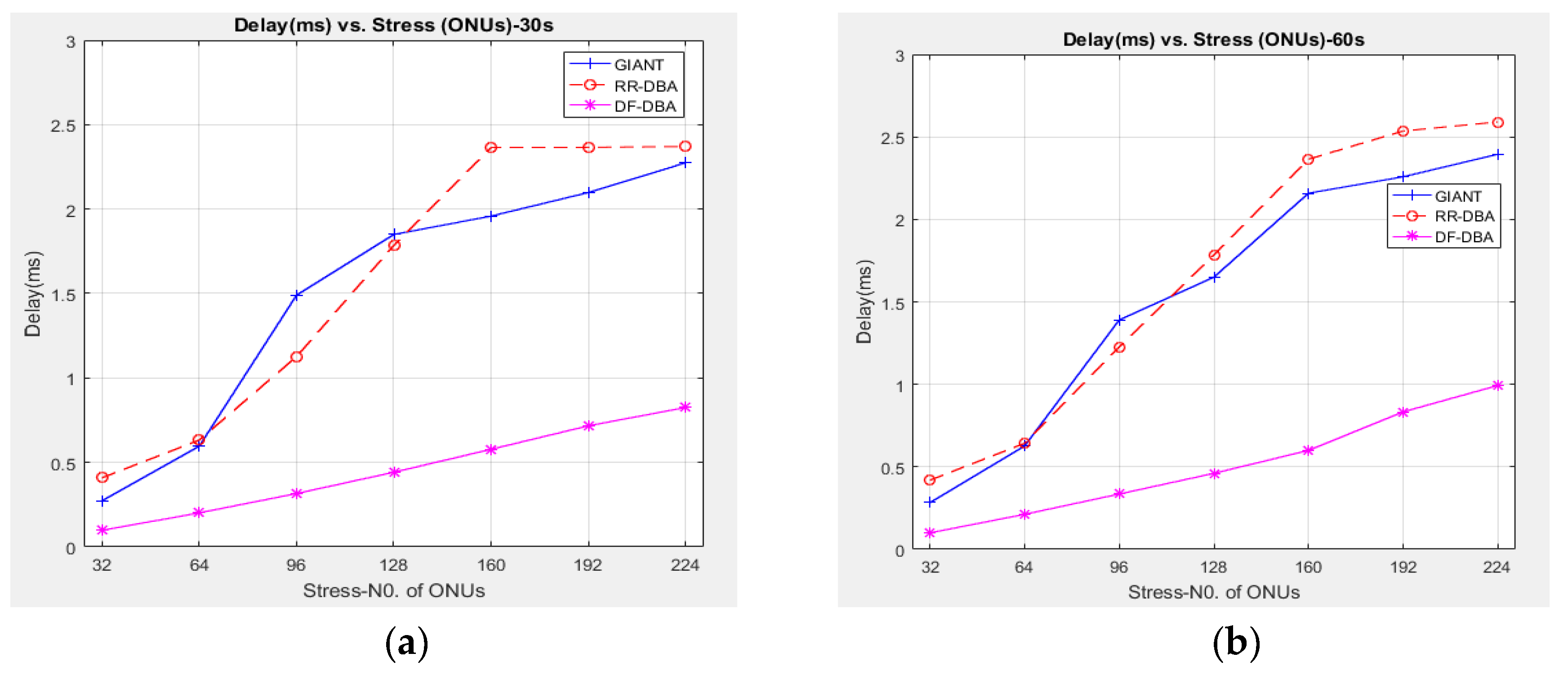
| Symbol | Description |
|---|---|
| λ(QTCONT) | Instantaneous data arrival rate at the ONU TCONTs queue |
| Req[i] | DBRu request sent in the ith frame |
| Data[i] | Amount of data sent in the ith frame |
| ΔT | Frame size, typically 125 μs |
| i | frame number |
| μ | Mean of last 100 values of λ(QTCONT) |
| σ | S.D. of the last 100 values of λ(QTCONT) |
| LTCONT | Predicted demand size |
| Algorithm |
|---|
| //Initialization |
| Globals: |
| int N = 100; // buffer size |
| int Req[N]; //DBRu request in the ith frame |
| int Data[N]; //data sent in the ith frame |
| int index = 0; |
| //Step# 1 Data &request frames saved in circular buffer at OLT |
| OnReceiveDataFrame(Frame) |
| { |
| index = (index + 1)% N; //circular buffer |
| Data[index] = Frame.ReceivedDataSize; |
| Req[index] = Frame.DBRU.GetBuffOccupancy(); |
| } |
| //Step#2 Calculate mean, variance, S.D and predict demand size |
| int PredictDemandSize() |
| { |
| int Sum = 0; for(i = 0; i<N; i++) |
| { |
| int i_minus_1 = ((i − 1)+N)%N; //circular buffer |
| sum += (Req[i] + Data[i] − Req[i_minus_1]); |
| } |
| double Mean = Sum/N; // mean is calculated |
| int Variance = 0; for(i = 0; i<N; i++) |
| { |
| int i_minus_1 = ((i − 1) + N)%N; //circular buffer |
| int Temp = (Req[i] + Data[i] − Req[i_minus_1]); |
| Variance += (Mean − Temp) * (Mean − Temp); |
| } |
| double Var = Variance/N; // variance is calculated |
| double SD = sqrt(Var); // S.D is calculated |
| int PredictedSize = NormalDist_Random(Mean,SD); |
| return PredictedSize + 128; // add piggybacks & predict demand size |
| } |
| Parameter | Value |
|---|---|
| OLT | 1 |
| Network Load(#ONUs) | 32, 64, 96, 128, 160, 192, 224 |
| Time | 30 s, 60 s |
| Upstream | 2.5 Gbps |
| Downstream | 10 Gbps |
| Packet size | 1472 bytes |
| Application | CBR, UDP |
| TCONT-type | 5 |
| Environment Area | 20 km |
| Parameters | RR | GIANT | DF-DBA |
|---|---|---|---|
| Working | Uses a task-based approach and runs each task once, if having a token. | Distributes bandwidth in very first iteration based on TCONTs priority. | Predicts future ONU demands by statistical modelling |
| Grant size | Less than or equal to a predetermined fixed size. | Ratio of data rate and US frame size. | Flexible, based on previous bandwidth requests and grants. |
| Grant time | Depends on OLT processing and grant time. | Depends on OLT processing and grant time. | Depends on OLT processing time |
| TCONT type | T1–T4 | T1–T4 | T5 |
| Processing with no. of ONUs | Slow | Medium | Fast |
| Throughput | Poor | Poor | High |
| PDR | Low | Medium | High |
| End to End Delay | High | High | Low |
© 2019 by the authors. Licensee MDPI, Basel, Switzerland. This article is an open access article distributed under the terms and conditions of the Creative Commons Attribution (CC BY) license (http://creativecommons.org/licenses/by/4.0/).
Share and Cite
Memon, K.A.; Mohammadani, K.H.; Ain, N.u.; Shaikh, A.; Ullah, S.; Zhang, Q.; Das, B.; Ullah, R.; Tian, F.; Xin, X. Demand Forecasting DBA Algorithm for Reducing Packet Delay with Efficient Bandwidth Allocation in XG-PON. Electronics 2019, 8, 147. https://doi.org/10.3390/electronics8020147
Memon KA, Mohammadani KH, Ain Nu, Shaikh A, Ullah S, Zhang Q, Das B, Ullah R, Tian F, Xin X. Demand Forecasting DBA Algorithm for Reducing Packet Delay with Efficient Bandwidth Allocation in XG-PON. Electronics. 2019; 8(2):147. https://doi.org/10.3390/electronics8020147
Chicago/Turabian StyleMemon, Kamran Ali, Khalid H. Mohammadani, Noor ul Ain, Arshad Shaikh, Sibghat Ullah, Qi Zhang, Bhagwan Das, Rahat Ullah, Feng Tian, and Xiangjun Xin. 2019. "Demand Forecasting DBA Algorithm for Reducing Packet Delay with Efficient Bandwidth Allocation in XG-PON" Electronics 8, no. 2: 147. https://doi.org/10.3390/electronics8020147
APA StyleMemon, K. A., Mohammadani, K. H., Ain, N. u., Shaikh, A., Ullah, S., Zhang, Q., Das, B., Ullah, R., Tian, F., & Xin, X. (2019). Demand Forecasting DBA Algorithm for Reducing Packet Delay with Efficient Bandwidth Allocation in XG-PON. Electronics, 8(2), 147. https://doi.org/10.3390/electronics8020147








